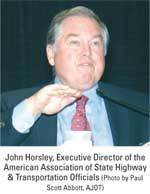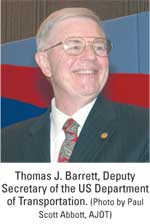By Paul Scott Abbott, AJOTA wider-reaching approach to port and connective infrastructure is imperative for survival in the global economy, according to several presentations by top officials at the American Association of Port Authorities’ 97th annual convention, held Sept. 21-25 in Anchorage, Alaska.
The more than 400 leaders of the Western Hemisphere port industry who gathered for the convention were repeatedly told that a commitment must be made to sufficiently fund a comprehensive transportation network.
This becomes particularly vital as US Congress looks toward reauthorization of federal surface transportation legislation with the September 2009 expiration date nearing for the Safe, Accountable, Flexible, Efficient Transportation Equity Act: A Legacy for Users, or SAFETEA-LU.

John Horsley, executive director of the American Association of State Highway and Transportation Officials, urged a broadened stance on transportation infrastructure, commenting that the United States is “no longer a self-sustained economy” and, in order to stay competitive in the global marketplace, must look at how China, Russia, European countries and other nations throughout the world are building their transportation infrastructures.
“We need to have an integrated infrastructure network that ties the entire North American continent together,” said Horsley, whose organization’s voting membership includes transportation departments of each US state.
He said the September bailout by Congress with an $8 billion transfer from general coffers to the Highway Trust Fund must be seen only as a temporary fix, commenting, “We’ll be back in the soup a year from now.”
Horsley warned that dramatic rises in construction commodity costs have severely eroded buying power for infrastructure projects, thus underscoring the need for a boost in freight network funding.

Thomas J. Barrett, deputy secretary of the US Department of Transportation, cautioned that delaying projects only adds to costs and said federal officials must encourage “innovative, creative ways” to finance intermodal projects while streamlining environmental processes.
Barrett, a retired US Coast Guard vice admiral, called for increased use of waterborne transportation, as supported by short-sea shipping efforts that now are referred to by DOT officials as the Marine Highway Initiative.
“We need to look more to water as a way to relieve landside congestion,” said Barrett, who added that, in addition to reducing roadway traffic jams, greater use of water transport is a cost-effective way to expand overall transportation system capacity while improving air quality.
Barrett called for approaching the transportation system as “an integrated whole,” with federal funding focused on projects with national impact and with greater implementation of public-private partnerships.
“The current system is broken,” he said. “Just how badly broken is not always apparent to people.”
Barrett termed the current funding mechanism, which relies heavily on fuel taxes, “schizophrenic,” noting that high gasoline prices, more fuel-efficient vehicles and government-supported conservation efforts have combined to decrease fuel consumption and thus slash available federal transportation dollars.
Sean T. Connaughton, administrator of the US Maritime Administration, a unit of DOT, stressed the importance of advancement of a national ports initiative and an increase in federal expenditures on maritime transportation.
“The US government needs to show more interest and more leadership in our ports if our economy is going to grow,” said Connaughton, who two weeks earlier was nominated by President Bush to chair the Feder
 John Horsley, executive director of the American Association of State Highway and Transportation Officials, urged a broadened stance on transportation infrastructure, commenting that the United States is “no longer a self-sustained economy” and, in order to stay competitive in the global marketplace, must look at how China, Russia, European countries and other nations throughout the world are building their transportation infrastructures.
“We need to have an integrated infrastructure network that ties the entire North American continent together,” said Horsley, whose organization’s voting membership includes transportation departments of each US state.
He said the September bailout by Congress with an $8 billion transfer from general coffers to the Highway Trust Fund must be seen only as a temporary fix, commenting, “We’ll be back in the soup a year from now.”
Horsley warned that dramatic rises in construction commodity costs have severely eroded buying power for infrastructure projects, thus underscoring the need for a boost in freight network funding.
John Horsley, executive director of the American Association of State Highway and Transportation Officials, urged a broadened stance on transportation infrastructure, commenting that the United States is “no longer a self-sustained economy” and, in order to stay competitive in the global marketplace, must look at how China, Russia, European countries and other nations throughout the world are building their transportation infrastructures.
“We need to have an integrated infrastructure network that ties the entire North American continent together,” said Horsley, whose organization’s voting membership includes transportation departments of each US state.
He said the September bailout by Congress with an $8 billion transfer from general coffers to the Highway Trust Fund must be seen only as a temporary fix, commenting, “We’ll be back in the soup a year from now.”
Horsley warned that dramatic rises in construction commodity costs have severely eroded buying power for infrastructure projects, thus underscoring the need for a boost in freight network funding.
 Thomas J. Barrett, deputy secretary of the US Department of Transportation, cautioned that delaying projects only adds to costs and said federal officials must encourage “innovative, creative ways” to finance intermodal projects while streamlining environmental processes.
Barrett, a retired US Coast Guard vice admiral, called for increased use of waterborne transportation, as supported by short-sea shipping efforts that now are referred to by DOT officials as the Marine Highway Initiative.
“We need to look more to water as a way to relieve landside congestion,” said Barrett, who added that, in addition to reducing roadway traffic jams, greater use of water transport is a cost-effective way to expand overall transportation system capacity while improving air quality.
Barrett called for approaching the transportation system as “an integrated whole,” with federal funding focused on projects with national impact and with greater implementation of public-private partnerships.
“The current system is broken,” he said. “Just how badly broken is not always apparent to people.”
Barrett termed the current funding mechanism, which relies heavily on fuel taxes, “schizophrenic,” noting that high gasoline prices, more fuel-efficient vehicles and government-supported conservation efforts have combined to decrease fuel consumption and thus slash available federal transportation dollars.
Sean T. Connaughton, administrator of the US Maritime Administration, a unit of DOT, stressed the importance of advancement of a national ports initiative and an increase in federal expenditures on maritime transportation.
“The US government needs to show more interest and more leadership in our ports if our economy is going to grow,” said Connaughton, who two weeks earlier was nominated by President Bush to chair the Feder
Thomas J. Barrett, deputy secretary of the US Department of Transportation, cautioned that delaying projects only adds to costs and said federal officials must encourage “innovative, creative ways” to finance intermodal projects while streamlining environmental processes.
Barrett, a retired US Coast Guard vice admiral, called for increased use of waterborne transportation, as supported by short-sea shipping efforts that now are referred to by DOT officials as the Marine Highway Initiative.
“We need to look more to water as a way to relieve landside congestion,” said Barrett, who added that, in addition to reducing roadway traffic jams, greater use of water transport is a cost-effective way to expand overall transportation system capacity while improving air quality.
Barrett called for approaching the transportation system as “an integrated whole,” with federal funding focused on projects with national impact and with greater implementation of public-private partnerships.
“The current system is broken,” he said. “Just how badly broken is not always apparent to people.”
Barrett termed the current funding mechanism, which relies heavily on fuel taxes, “schizophrenic,” noting that high gasoline prices, more fuel-efficient vehicles and government-supported conservation efforts have combined to decrease fuel consumption and thus slash available federal transportation dollars.
Sean T. Connaughton, administrator of the US Maritime Administration, a unit of DOT, stressed the importance of advancement of a national ports initiative and an increase in federal expenditures on maritime transportation.
“The US government needs to show more interest and more leadership in our ports if our economy is going to grow,” said Connaughton, who two weeks earlier was nominated by President Bush to chair the Feder



